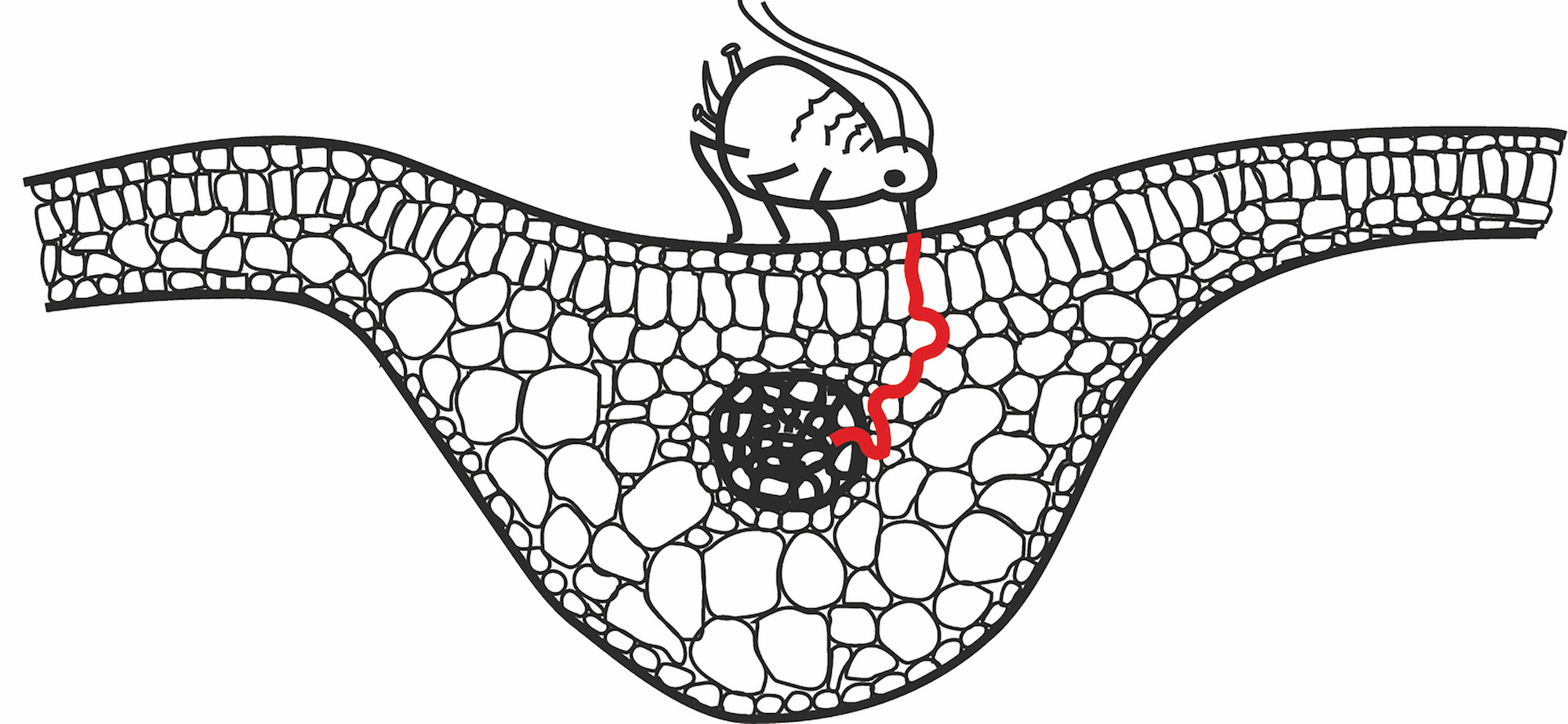 Plant Biology
Plant Biology
Smart plant defense against a stealthy herbivore
A newly discovered protein helps plants to defend themselves against aphids. It restricts these stealthy insects from draining sugar-rich sap from the plant. Farmers and plant breeders are excited, as this protein could help to reduce chemical application on food crops.

Many vegetables, fruits and ornamental flowers you buy in shops, have been treated with chemicals. The reason for this is that herbivorous insects and pathogens that would otherwise destroy these crops had to be killed. The use of pesticides and insecticides is not harmless and is a main suspect for the rapid decline in insect and bird biodiversity in Western Europe.
The question is whether we need to "help" plants with chemicals. Are they incapable of solving these problems themselves? The answer is no. During millions of years, plants have evolved many ways to defend themselves against e.g. pathogenic fungi, chewing caterpillars, and piercing-sucking aphids. Yet, many crops have lost natural defense mechanisms. Time, thus, to find out how their natural relatives are beating their enemies!
Our quest was to find natural resistance mechanisms to aphids in wild cabbage plants. Aphids are phloem-feeding insects. They are a huge problem for many crops on the northern hemisphere because they transfer viruses and drain plants from precious sugars and amino acids. They use their needle-like mouth to penetrate the plant. With their stylets, they navigate between plant cells and aim for a phloem tube where plant sap is translocated. Once a phloem tube is punctured, they can feed for hours or even days. The phloem sap is under high pressure, and the aphids virtually only need to open their mouth to passively ingest this sugar-rich plant juice.
To find natural resistance mechanisms to aphids in wild cabbage plants, we studied the feeding behavior of Myzus persicae, green peach aphids, on 350 wild Arabidopsis thaliana, thale cress, plants. These plants belonged to the same species but differed slightly in their DNA code. Our aim was to see if differences in aphid behavior were related to a specific variation in the DNA code of these plants. We first build a video platform to screen aphid feeding behavior. We released each aphid on a half-cm wide leaf disc and recorded their behavior with a video camera. Special software was used to analyze the video footage. When aphids were sitting on the leaf disc without moving, the software annotated that the aphid was probably penetrating the plant tissue.
After thousands of hours of recording (between 3 to 6 aphids per plant line), we had a robust data set for Genome-Wide Association mapping. With this statistical method, we compared aphid behavior with the DNA code of the plants. Interestingly, there was a strong association between the duration of aphid penetrations and variations in the DNA code of one particular plant gene. This gene bore the information to build a protein with unknown function.
To test if this gene really increased plant resistance to aphids, we screened genetically modified plants with and without this specific protein. On plants without the protein, aphids were feeding for much longer than on plants with the heat-shock like protein. The effects were particularly strong when plants were exposed to heat stress. Aphids also secreted less honeydew droplet excretions during feeding, indicating that this protein restricted the rate of phloem sap ingestion. Aphids also produced less offspring on plants with the protein. This confirmed that we indeed had found a new aphid resistance gene!
But what is this protein doing? To find out where the protein was located in plants, we constructed Arabidopsis plants with a fluorescent version of the protein. Confocal microscopy showed that the protein was confined to phloem tubes and did not occur in other cells. Phloem tubes are living cells with an empty lumen for sap transport and only have a few organelles along the wall. Surprisingly, the protein did not seem to be present in the phloem sap. Instead, it coated the tubes and sometimes formed circular shapes along the tube walls. With fluorescent markers, we found that the protein most likely resides in the endoplasmatic reticulum and sometimes covers mitochondria. Further research has to point out how this protein exactly prevents aphids from ingesting phloem sap. Hopefully, this new resistance gene can help plant breeders to increase natural plant defenses in crops and reduce the use of insecticides.
Original Article:
K. J. Kloth et al., SIEVE ELEMENT-LINING CHAPERONE1 Restricts Aphid Feeding on Arabidopsis during Heat Stress. Plant Cell 29, 2450-2464 (2017)Edited by:
Massimo Caine , Founder and Director
We thought you might like
Attractive in the dark — how petunias may help to feed humanity
Apr 27, 2016 in Plant Biology | 3 min read by Graham RobinsonOut of the darkness: how plants prepare for, and endure, life in the sun
Nov 28, 2016 in Plant Biology | 3 min read by Graham RobinsonCapturing Mother Nature at work: seeing how plants make vitamin B6
Feb 16, 2017 in Plant Biology | 4 min read by Graham Robinson , Teresa FitzpatrickOne root for every soil: a double-personality tale
Sep 12, 2017 in Plant Biology | 3 min read by Laura LorenzoMore from Plant Biology
Unravelling the Secrets of Pine Roots: A Tale of Nutrition and Adaptation
Oct 20, 2023 in Plant Biology | 3.5 min read by Rafael Cañas , Francisco OrtigosaStressful memories help plants resist caterpillars
Oct 2, 2023 in Plant Biology | 3.5 min read by Samuel Wilkinson , Adam Hannan Parker , Jurriaan TonDecoding the genome of a jackfruit that grows all year round
Sep 6, 2023 in Plant Biology | 3.5 min read by Tofazzal IslamLife after logging: the tale of recovering tropical forests
Aug 21, 2023 in Plant Biology | 3.5 min read by Maria Mills , Terhi RiuttaEditor's picks
Trending now
Popular topics


